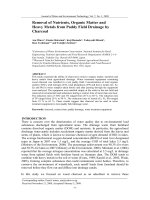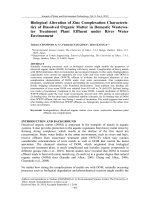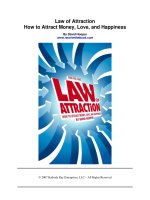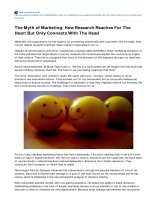A Universe of Consciousness Edelman FM Edelman, g tononi, g a universe of consciousness how matter becomes imagination
Bạn đang xem bản rút gọn của tài liệu. Xem và tải ngay bản đầy đủ của tài liệu tại đây (2.48 MB, 289 trang )
US $18.00/$21.95 CAN
ISBN-13: 978-0-465-01377-7
ISBN-10: 0-465-01377-5
A Member of the Perseus Books Group
www.basicbooks.com
Edelman-FM.qxd
6/24/04
12:09 PM
Page i
A Universe of
Consciousness
Edelman-FM.qxd
6/24/04
12:09 PM
Page ii
DETAIL FROM MICHELANGELO’S CREATION OF ADAM IN THE SISTINE CHAPEL.
God is pictured on a background that bears more than a passing resemblance to a
section of the human brain. A detailed comparison can be found in F. L. Meshberger,
“An Interpretation of Michelangelo’s Creation of Adam Based on Neuroanatomy,”
Journal of the American Medical Association, 264 (1990), 1837– 41.
Edelman-FM.qxd
6/24/04
12:09 PM
Page iii
A Universe of
Consciousness
H O W M AT T E R B E C O M E S
I M A G I N AT I O N
GERALD M. EDELMAN
AND
GIULIO TONONI
A Member of the Perseus Books Group
Edelman-FM.qxd
6/24/04
12:09 PM
Page iv
OTHER WORKS BY GERALD M. EDELMAN
The Mindful Brain: Cortical Organization and the
Group-Selective Theory of Higher Brain Function
Neural Darwinism: The Theory of Neuronal Group Selection
Topobiology
The Remembered Present: A Biological Theory of Consciousness
Bright Air, Brilliant Fire: On the Matter of the Mind
Copyright © 2000 by Gerald M. Edelman and Giulio Tononi.
Published by Basic Books,
A Member of the Perseus Books Group
All rights reserved. Printed in the United States of America. No part of this book may be
reproduced in any manner whatsoever without written permission except in the case of
brief quotations embodied in critical articles and reviews. For information, address Basic
Books, 387 Park Avenue South, New York, NY 10016-8810.
Book Designed by Kris Tobiassen
FIRST PAPERBACK EDITION
A CIP catalog record of this book is available from the Library of Congress.
ISBN 0-465-01377-5
20 19 18 17 16 15 14 13 12 11 10 9 8 7
Edelman-FM.qxd
6/24/04
12:09 PM
Page v
Contents
Illustrations
vii
Acknowledgments
ix
Preface
xi
PA R T I
THE WORLD KNOT
1 Consciousness: Philosophical Paradox or Scientific Object?
3
2 The Special Problem of Consciousness
10
3 Everyman’s Private Theater: Ongoing Unity, Endless Variety
20
PA R T I I
CONSCIOUSNESS AND THE BRAIN
4 Building a Picture of the Brain
37
5 Consciousness and Distributed Neural Activity
51
6 Neural Activity Integrated and Differentiated
62
PA R T I I I
MECHANISMS OF CONSCIOUSNESS:
THE DARWINIAN PERSPECTIVE
7 Selectionism
8 Nonrepresentational Memory
9 Perception into Memory: The Remembered Present
79
93
102
Edelman-FM.qxd
6/24/04
12:09 PM
vi
Page vi
CONTENTS
PA R T I V
DEALING WITH PLETHORA:
THE DYNAMIC CORE HYPOTHESIS
10 Integration and Reentry
113
11 Consciousness and Complexity
125
12 Determining Where the Knot Is Tied: The Dynamic Core Hypothesis
139
PA R T V
U N TA N G L I N G T H E K N O T
13 Qualia and Discrimination
157
14 The Conscious and the Unconscious
176
PA R T V I
OBSERVER TIME
15 Language and the Self
193
16 Thinking
200
17 Prisoners of Description
207
Notes
223
Bibliography
253
Credits
265
Index
267
Edelman-FM.qxd
6/24/04
12:09 PM
Page vii
Illustrations
Frontispiece: Detail from Michelangelo’s Creation of Adam
1.1 Diagram by Descartes on how the brain forms mental images
2.1 A skeleton observing a skull, an engraving by Andreas Vesalius
2.2 William James
3.1 Virgin Forest with Setting Sun by Henri Rousseau
3.2 An ambiguous figure
3.3 Drawing by a patient with left hemineglect
3.4 Shot sequence from Eisenstein’s Potemkin
4.1 Gross anatomy of the brain
4.2 Two illustrations by Ramon y Cajal
4.3 Diagram of a synapse
4.4 Three topological arrangements of brain neuroanatomy
5.1 Distributed neural processes underlying conscious experience
revealed by MEG
6.1 The corpus callosum
6.2 Anna O., a patient of Sigmund Freud
6.3 Coherence of neural processes underlying consciousness
6.4 EEG patterns during epilepsy and sleep
6.5 La Notte (The Night ), by Michelangelo
7.1 Charles Darwin
7.2 Diagram of the theory of neuronal group selection
7.3 Diagram of a value system
7.4 Darwin IV tracking colored cubes
8.1 Diagram of a global mapping
8.2 Knik glacier, Alaska
9.1 Mechanisms of primary consciousness
5
13
18
21
25
28
30
38
39
41
43
56
63
65
70
72
73
80
84
89
90
96
100
108
Edelman-FM.qxd
viii
10.1
10.2
10.3
10.4
11.1
11.2
11.3
12.1
13.1
13.2
13.3
14.1
6/24/04
12:09 PM
Page viii
ILLUSTRATIONS
What is connected to what in the cerebral cortex
Diagram of a computer model of cortical integration
Solving the binding problem
Diagram of functional clustering
Diagram of mutual information
Diagram of complexity
How complexity varies, depending on neuroanatomical organization
M83, a spiral galaxy, in Hydra
Color space
Qualia space
Spring model of the dynamic core
Structures and connections mediating conscious and
unconscious processes
15.1 A scheme of higher-order consciousness
17.1 Diagram of a Turing machine
17.2 Counterpart, by Arcimboldo
115
116
117
122
128
129
132
145
162
164
172
179
194
213
221
Edelman-FM.qxd
6/24/04
12:09 PM
Page ix
Acknowledgments
We wish especially to thank our colleagues Ralph Greenspan, Olaf Sporns,
and Chiara Cirelli for their useful suggestions and thought-provoking discussions during the writing of this book. We are also grateful to David
Sington for his penetrating editorial suggestions and critical analysis. Jo Ann
Miller, the executive editor of Basic Books, gave us valuable help in clarifying portions of the text. We, of course, take full responsibility for any inadvertent errors and deficiencies that may remain. Many of the ideas and most
of the work described here occurred at the Neurosciences Institute, whose
Fellows are dedicated to understanding how the brain gives rise to the mind.
Edelman-FM.qxd
6/24/04
12:09 PM
Page x
Edelman-FM.qxd
6/24/04
12:09 PM
Page xi
Preface
Consciousness has been seen as both a mystery and a source of mystery. It is
one of the main targets of philosophical inquiry, but only recently has it
been accepted into the family of scientific objects that are worthy of experimental investigation. The reasons for this late acceptance are clear:
Although all scientific theories assume consciousness and conscious sensation and perception are necessary for their application, the means to carry
out scientific investigations of consciousness itself have only recently
become available.
There is something special about consciousness: Conscious experience
arises as a result of the workings of each individual brain. It cannot be shared
under direct observation, as the physicist’s objects can be shared. Thus,
studying consciousness presents us with a curious dilemma: Introspection
alone is not scientifically satisfactory, and though people’s reports about
their own consciousness are useful, they cannot reveal the workings of the
brain underlying them. Yet, studies of the brain proper cannot, in themselves, convey what it is like to be conscious. These constraints suggest that
one must take special approaches to bring consciousness into the house of
science.
In this book, we do just that, and we develop ways to answer the following questions:
1. How does consciousness arise as a result of particular neural
processes and of the interactions among the brain, the body, and the
world?
2. How do these neural processes account for key properties of
conscious experience? Each conscious state is unified and indivisible,
Edelman-FM.qxd
xii
6/24/04
12:09 PM
Page xii
PREFACE
yet at the same time, each person can choose among an immense
number of different conscious states.
3. How can we understand different subjective states—so-called
qualia—in neural terms?
4. How can our understanding of consciousness help connect strictly
scientific descriptions to the wider domain of human knowledge and
experience?
To describe the neural mechanisms that give rise to consciousness, to
show how the general properties of consciousness emerge as a result of the
properties of the brain as a complex system, to analyze the origins of subjective states or qualia, and to show how the successful pursuit of all these
efforts may change our views of the scientific observer and of long-held
philosophical positions is, of course, a tall order, and in the short compass of
this volume much of interest must be omitted. But the main outlines of a
solution to the problem of consciousness can be sketched by paying close
attention to our four basic questions. Our answers are based on the assumption that consciousness arises within the material order of certain organisms.
However, we emphatically do not identify consciousness in its full range as
arising solely in the brain, since we believe that higher brain functions
require interactions both with the world and with other persons.
Once we establish this new understanding of how consciousness emerges,
we touch on several interesting issues that derive from this perspective. We
propose a new view of the scientific observer, and we explore how we can
know what we know— the realm of epistemology. Finally, we discuss the
question of which subjects are appropriate for scientific study. Exposing
these matters to scrutiny is important because our position— that consciousness arises as a particular kind of brain process that is both highly unified (or
integrated) and highly complex (or differentiated)—has wide-ranging implications.
To untangle the bases of consciousness and account for some of its properties, we consider a number of challenging subjects. Indeed, before we get
to the central issue, the neural substrate of consciousness, we review structural and functional features of brain organization, as well as certain essential aspects of brain theory. To make the task easier for the reader, we have
prefaced each major part of the book with a prologue and each chapter with
a brief introduction. We suggest that to obtain a synoptic view, the reader
peruse in order the six prologues and the introductions to the chapters.
Doing so will help keep the whole picture in mind, especially in chapters
Edelman-FM.qxd
6/24/04
12:09 PM
Page xiii
PREFACE
xiii
that are necessary for analyzing consciousness but are not directly concerned
with it. As for the later chapters, only two (chapters 10 and 11) have explicit
mathematical content. The reader who is not inclined to follow the details
may get a reasonable understanding of their meaning by perusing the figures
and “humming the tune.” For those who wish to pursue specific issues or
references, we have placed notes at the back of the book. The notes are not,
however, necessary for comprehending our argument. We hope that by the
end of the journey through the text, readers will find themselves with a new
view of how matter becomes imagination.
Edelman-FM.qxd
6/24/04
12:09 PM
Page xiv
Edelman_01-02.qxd
6/24/04
12:11 PM
Page 1
P A R T
O N E
The World Knot
When I turn my gaze skyward I see the flattened dome of the sky and the
sun’s brilliant disc and a hundred other visible things underneath it. What are
the steps which bring this about? A pencil of light from the sun enters the eye
and is focussed there on the retina. It gives rise to a change, which in turn
travels to the nerve layer at the top of the brain. The whole chain of these
events, from the sun to the top of my brain, is physical. Each step is an electrical reaction. But now there succeeds a change wholly unlike any that led up
to it, and wholly inexplicable by us. A visual scene presents itself to the mind:
I see the dome of the sky and the sun in it, and a hundred other visual things
beside. In fact, I perceive a picture of the world around me.1
With this simple example, in 1940, the great neurophysiologist Charles
Sherrington illustrated the problem of consciousness and his belief that it
was scientifically inexplicable.
A few years earlier, Bertrand Russell used a similar example to express his
skepticism about the ability of philosophers to arrive at a solution:
We suppose that a physical process starts from a visible object, travels to the
eye, there changes into another physical process, causes yet another physical
process in the optic nerve, and finally produces some effects in the brain,
simultaneously with which we see the object from which the process started,
the seeing being something “mental,” totally different in character from the
Edelman_01-02.qxd
2
6/24/04
A
12:11 PM
UNIVERSE
OF
Page 2
CONSCIOUSNESS
physical processes, which precede and accompany it. This view is so queer
that metaphysicians have invented all sorts of theories designed to substitute
something less incredible.2
No matter how accurate the description of the physical processes underlying it, it is hard to conceive how the world of subjective experience—the
seeing of blue and the feeling of warmth—springs out of mere physical
events. And yet, in an age in which brain imaging, general anesthesia, and
neurosurgery are becoming commonplace, we are aware that the world of
conscious experience depends all too closely on the delicate workings of the
brain. We are aware that consciousness, in all its glory, can be annihilated by
a minuscule lesion or a slight chemical imbalance in certain parts of the
brain. In fact, our conscious life is annihilated every time the mode of activity in our brain changes and we fall into dreamless sleep. We are also aware
that our own private consciousness is, in a profound sense, all there is. The
flattened dome of the sky and the hundred other visible things underneath,
including the brain itself—in short, the entire world—exist, for each of us,
only as part of our consciousness, and they perish with it. This enigma
wrapped within a mystery of how subjective experience relates to certain
objectively describable events is what Arthur Schopenhauer brilliantly called
the “world knot.”3 Despite the appearance of mystery, the best hope of disentangling this knot will come from a scientific approach that combines
testable theories and well-designed experiments. This book is dedicated to
this end.
Edelman_01-02.qxd
6/24/04
12:11 PM
Page 3
C H A P T E R
O N E
Consciousness:
Philosophical Paradox
or Scientific Object?
The subject of consciousness has not lacked for human attention. In the past, it was
the exclusive domain of philosophers, but recently both psychologists and neuroscientists have begun to attack the so-called mind-body problem or, in Schopenhauer’s
suggestive phrase, “the world knot.” In this chapter we briefly review classical and
modern approaches to consciousness. We point out various positions taken by philosophers, psychologists, and neuroscientists, rejecting some of the more flagrant ones,
such as dualism or extreme reductionism. We suggest that consciousness can be considered a scientific subject and that it is not the sole province of philosophers.
Everyone knows what consciousness is: It is what abandons you every
evening when you fall asleep and reappears the next morning when you
wake up. This deceptive simplicity reminds us of what William James said of
attention at the turn of the century: “Everyone knows what attention is. It is
the taking possession by the mind, in clear and vivid form, of one out of
what seem several simultaneously possible objects or trains of thought.”1
More than one hundred years later, many think that neither attention nor
consciousness is understood in any fundamental sense.
This lack of understanding is certainly not because of lack of attention in
philosophical or scientific circles. Ever since René Descartes, few subjects
Edelman_01-02.qxd
4
6/24/04
A
12:11 PM
UNIVERSE
OF
Page 4
CONSCIOUSNESS
have preoccupied philosophers so consistently as the riddle of consciousness.
For Descartes, as for James more than two centuries later, to be conscious
was synonymous with “to think”: James’s stream of thought, for example,
was nothing but the stream of consciousness. The cogito ergo sum, “I think
therefore I am,” which Descartes posed as the foundation of his philosophy
in his Meditationes de Prima Philosophia,2 was a direct recognition of the centrality of consciousness with respect to both ontology (what is) and epistemology (what and how we know).
If taken too seriously, “I am conscious, therefore I exist” can lead to solipsism, the view that nothing exists but one’s individual consciousness, evidently not a view that can appeal to two authors who are sharing the writing
of a book. More realistically (pun intended), that starting point leads to idealistic positions that emphasize mind over matter—ideas; perception;
thought; or, in one word, consciousness. By taking mind as a starting point,
however, idealistic philosophies must take pains to explain matter—which is
not necessarily a better predicament than starting from mere matter to
derive mind.
Descartes argued that there is an absolute distinction between mental
and material substance. The defining characteristic of matter, he thought, is
to be extended, to occupy space, and thus be susceptible to physical explanation, whereas the defining characteristic of mind is to be conscious or, in a
broad sense of the term, to think. In this view, mental substance exists in the
form of individual minds. In this way, Descartes inaugurated dualism, a position that is unsatisfactory scientifically but appears intuitively simple and
appealing until one attempts to explain the connection between the mind
and the body (see figure 1.1). Since the days of Descartes, philosophers have
suggested versions of dualism or related alternatives. For example, a related
theory is epiphenomenalism, which agrees with other theories in holding
that mental events and physical events are different but maintains that the
only true causes of mental experiences are physical events, with mind as a
causally inefficacious by-product. In the words of Thomas Huxley, “consciousness would appear to be related to the mechanism of [the] body simply
as a collateral product of its working, and to be as completely without any
power of modifying that working as the steam whistle that accompanies the
working of a locomotive engine is without influence upon its machinery.”3
In more recent times, philosophers have taken a materialistic stance,
holding that the mind and consciousness are identical to the operations of
the brain or, at least, to certain of these operations. Some materialistic positions go so far as to deny any ontological or epistemic validity to conscious-
Edelman_01-02.qxd
6/24/04
12:11 PM
PHILOSOPHICAL
Page 5
PARADOX
OR
SCIENTIFIC
OBJECT?
5
ness; they insist that there is literally nothing else beyond the functioning of
brain circuits or, at least, that there is nothing else that needs to be
explained. Several philosophers have suggested that once we understand the
workings of the brain sufficiently well, the concept of consciousness will
evaporate just as the concept of phlogiston (a hypothetical volatile constituent of all combustible substances that was thought to be released as a
flame in combustion) evaporated when oxidation was understood. The
mind-body problem is thus made to disappear by denying or explaining
away the consciousness side of it. Other materialistic positions insist that
although consciousness is generated by physical events in the brain, it is not
reduced to them but, rather, emerges from them, just as the properties of
water emerge from the chemical combination of two hydrogens and one
oxygen but are not directly reducible to the properties of hydrogen or oxygen alone. Such positions come in various flavors, but, in general, they grant
consciousness some residual status, at least from the point of view of explanation. Nevertheless, they insist that there is no “consciousness” substance
separate from a “brain” substance.
The philosophical debate on the mind-body problem is by now
extremely sophisticated and, in their variety, some current disputes rival
those that flourished among post-Cartesian philosophers. As we had
FIGURE 1.1 A diagram by Descartes illustrating his ideas about how the brain forms
mental images of an object. The transaction between mental substance and physical
substance was supposed to take place in the pineal gland (H).
Edelman_01-02.qxd
6
6/24/04
A
12:11 PM
UNIVERSE
OF
Page 6
CONSCIOUSNESS
Spinoza’s dual-aspect theory, Malebranche’s occasionalism, Leibniz’s parallelism and his doctrine of preestablished harmony, we now have the identity
theory, the central state theory, neutral monism, logical behaviorism, token
physicalism and type physicalism, token epiphenomenalism and type
epiphenomenalism, anomalous monism, emergent materialism, eliminative
materialism, various brands of functionalism, and many others.4
Despite the profusion of philosophical positions, it appears unlikely that
philosophical arguments alone will lead to a satisfactory solution to the
mind-body problem. In the words of Colin McGinn,5 a philosopher who
takes an extreme position: “We have been trying for a long time to solve the
mind-body problem. It has stubbornly resisted our best efforts. The mystery
persists. I think the time has come to admit candidly that we cannot solve
the mystery. [We still have no idea of how] the water of the physical brain is
turned into the wine of consciousness.”
There is indeed a fundamental limitation on philosophical efforts to discern the origins of consciousness that arises, in part, from the presumption
that the sources of conscious thought can be revealed by thinking alone.
This presumption is as patently inadequate as efforts in previous times to
understand cosmogony, the basis of life, and the fine structure of matter in
the absence of scientific observations and experiments. In fact, philosophers
have excelled not so much in proposing solutions to the problem but in
pointing out just how intractable the problem is. What many philosophers
are reiterating amounts to this: No matter what scientists do, the firstperson and third-person perspectives of conscious individuals will not be reconciled, the explanatory gap will not be bridged, and the “hard” problem—
the generation of sensations, of phenomenal or experiential states out of the
buzzing of neurons—will not be solved.6
How have scientists fared in explaining the mystery? If we look at psychology, we find that the “science of the mind” always had trouble in accommodating what should be its central topic—consciousness—within an
acceptable theoretical framework. The introspectionist tradition of
Titchener and Külpe7 was the psychological counterpart of idealistic or phenomenological positions in philosophy; it attempted to describe consciousness viewed by the individual exclusively from the inside, hence the term
introspection. Many introspectionists were psychological atomists; not unlike
some present-day neurophysiologists, they postulated that consciousness
was made up of elementary parts that could be catalogued (never mind that
the American school came up with more than 40,000 sensations and the
German school with just 12,000). By contrast, behaviorists notoriously
Edelman_01-02.qxd
6/24/04
12:11 PM
PHILOSOPHICAL
Page 7
PARADOX
OR
SCIENTIFIC
OBJECT?
7
attempted to eliminate consciousness completely from scientific discourse, a
position not unlike that of some contemporary philosophers.
Present-day cognitive psychologists have reintroduced consciousness and
mind as legitimate concepts. They conceive of consciousness as either a special module or a stage in the flowchart delineating an information-processing
hierarchy. In fact, cognitive psychologists often consider consciousness in
terms of a limited-capacity bottleneck in our mental functioning, possibly
due to an unspecified limitation of our brains. Several such models of the
functions associated with consciousness have been formulated, drawing their
inspiration from cognitive psychology or artificial intelligence or using
metaphors borrowed from computer science, such as that of a central executive system or an operating system. Psychologists have also used the
metaphor of consciousness as a unified stage, scene, or theater in which
information from multiple sources is integrated for the control of behavior.8
Some of these intuitions may point in the right direction, while others may
be as misleading as they are potentially appealing.
What is certain, however, is that such metaphors cannot substitute for a
genuine scientific understanding of consciousness. Cognitive models usually
have little to offer vis-à-vis the experiential, phenomenal side of conscious
experience. Looked at from the perspective of these models, consciousness
as a phenomenal experience (and often an emotional one) may as well not
exist, as long as some of its presumed functions, such as control, coordination, and planning, can be carried out. Standard cognitive accounts offer no
convincing explanation of why multiplication performed by a human is a
slow and hesitant conscious process while the same multiplication quickly
carried out by a pocket calculator is presumably not conscious at all. Nor do
they explain why the complicated processes needed to balance your weight
when you walk or to articulate words when you speak should remain
unconscious, while the simple application of pressure to your finger produces a conscious experience. Finally, as many critics have pointed out, any
information-processing, strictly functionalistic approach to consciousness
has little to say about the fact that consciousness requires the activity of specific neural substrates. These substrates are actually the central concern of
neuroscientists.
Except for fundamental observations about coma, anesthesia, and the
like, neuroscientists used to be exceedingly careful in their approaches to
consciousness. Most profess a convenient agnosticism about the subject and
justify their caution by our present ignorance. Although many of them
would probably subscribe to some kind of system-level explanation—if only
Edelman_01-02.qxd
8
6/24/04
A
12:11 PM
UNIVERSE
OF
Page 8
CONSCIOUSNESS
they knew which one—for the present, they deem it more fruitful painstakingly to collect new facts and observations and to leave theorizing to the
future. Over the past decade or so, however, something has definitely
changed in the relationship between studies of consciousness and the neurosciences. Scientists seem less afraid of addressing the subject unabashedly,
several books by neuroscientists have appeared, new journals have been
launched, and studies have been conducted in which consciousness was actually treated as an experimental parameter.9
Although certain recent “scientific” hypotheses do not cover as wide a
spectrum as that offered by philosophers, they are in some ways even more
exotic or extreme. For example, some neuroscientists have embraced dualistic positions according to which the conscious mind interfaces with the brain
by virtue of “psychons” communicating with “dendrons” in certain areas of
the left brain (Descartes suggested that the pineal gland was the site of the
interaction because it is situated in the middle of the head).10 Some scientists
(who may or may not qualify as neuroscientists) have concluded that conventional physics is not enough of a basis for theorizing about consciousness—one has to invoke esoteric physical concepts, such as quantum gravity,
to explain consciousness.11
Others have pursued what appears to be a more profitable strategy—
focusing on the search for specific neural correlates of consciousness.
Indeed, in this area definite progress has been made. For example, given the
limited neurological knowledge of his times, James had to conclude that the
neural basis for consciousness was nothing less than the whole brain.12
Today, scientists are able to be more sophisticated and specific. Different
authors believe that different brain structures support consciousness,
structures with forbidding names, such as the intralaminar thalamic nuclei,
reticular nucleus, mesencephalic reticular formation, tangential intracortical network of layers I-II, and thalamocortical loops. Controversies rage
over issues that were unthinkable at the time of James’s writing: Does the primary visual cortex contribute to conscious experience or not? Are areas of the
brain that project directly to the prefrontal cortex more relevant than those
that do not? Does only a particular subset of cortical neurons play a role? If
so, are these neurons characterized by a special property or location? Do
cortical neurons need to oscillate at 40 Hz or fire in bursts to contribute to
conscious experience? Do different areas of the brain or groups of neurons
generate different conscious fragments—a kind of microconsciousness?13
These questions are being debated more and more frequently, and new
experimental data are fueling the debate. Yet, as this profusion of various
Edelman_01-02.qxd
6/24/04
12:11 PM
PHILOSOPHICAL
Page 9
PARADOX
OR
SCIENTIFIC
OBJECT?
9
questions and hypotheses indicates, something is definitely missing in
attempts to identify the neural basis of consciousness with this or that set of
neurons. Again, we confront the world knot. By what mysterious transformation would the firing of neurons located in a particular place in the brain
or endowed with a particular biochemical property become subjective experience, while the firing of other neurons would not? It is not surprising that
some philosophers view such attempts as prime examples of a category
error—the error of ascribing to things properties that they cannot have.14
It is also not surprising that such errors are made, given how special consciousness is as a scientific object. In the next chapter we consider how the
fundamental problem posed by this specialness may be confronted. We take
the position that consciousness is not an object but a process and that,
looked at from this point of view, it is indeed a fitting scientific subject.
Edelman_01-02.qxd
6/24/04
12:11 PM
Page 10
C H A P T E R
T W O
The Special Problem of
Consciousness
Science has always tried to eliminate the subjective from its description of the world. But
what if subjectivity itself is its subject? In this chapter, we first explore the special status
of consciousness and the assumptions necessary to study it from a scientific point of view.
We then examine a fundamental problem posed by the existence of consciousness—one
that needs to be explained by any scientific account. Consider this simple example: Why
is it that when each of us performs certain discriminations, such as between light and
dark, each of us is conscious, but a similar discrimination performed by a simple physical
device is apparently not associated with conscious experience? This paradox suggests that
attempts to understand consciousness that rely on the intrinsic properties of certain neurons or certain areas of the brain are doomed to failure. Next, we discuss the kinds of
new approaches required if the bases of consciousness are to be understood. Finally, we
delineate our strategy—to identify and characterize not just the neurons but the neural
processes that can account for key properties of conscious experience.
We have looked at some of the obvious difficulties and uncertainties faced
by both philosophers and scientists when dealing with consciousness. It is
important to recognize the origin of these difficulties. Consciousness poses a
special problem that is not encountered in other domains of science. In
physics and chemistry, we are used to explaining certain entities in terms of
other entities and laws. We can describe water with ordinary language, but









